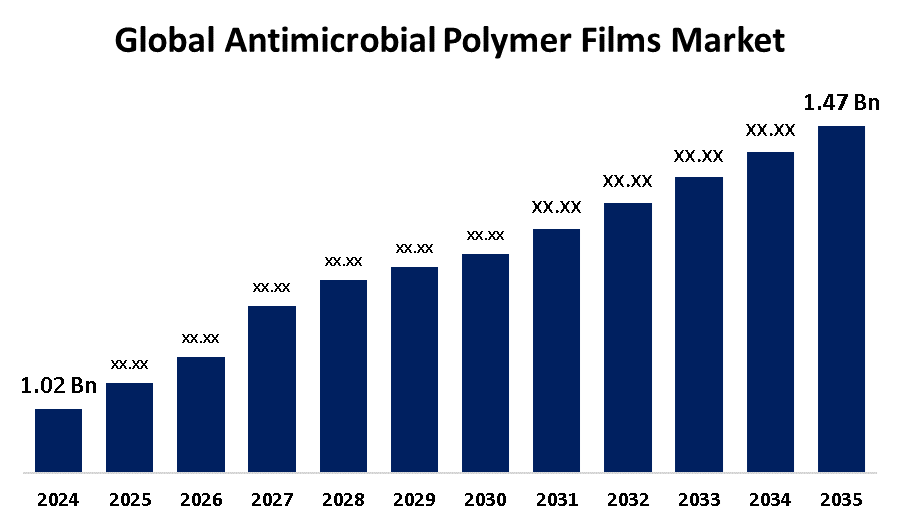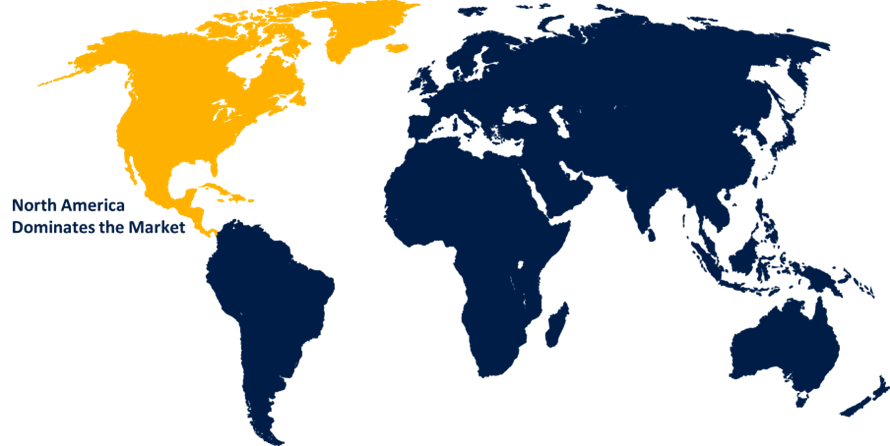Global Antimicrobial Polymer Films Market Size, Share, and COVID-19 Impact Analysis, By Material (Natural Polymers, Synthetic Polymers, and Biodegradable Polymers), By Antimicrobial Agent (Metal-Based Agents, Organic Agents, Quaternary Organic Compounds, Chitosan & Derivatives, and Others), and By Region (North America, Europe, Asia-Pacific, Latin America, Middle East, and Africa), Analysis and Forecast 2025 - 2035
Industry: HealthcareGlobal Antimicrobial Polymer Films Market Insights Forecasts to 2035
- The Global Antimicrobial Polymer Films Market Size Was Estimated at USD 1.02 Billion in 2024
- The Market Size is Expected to Grow at a CAGR of around 3.38% from 2025 to 2035
- The Worldwide Antimicrobial Polymer Films Market Size is Expected to Reach USD 1.47 Billion by 2035
- Asia Pacific is expected to grow the fastest during the forecast period.

Get more details on this report -
The global antimicrobial polymer films market size was worth around USD 1.02 billion in 2024 and is predicted to grow to around USD 1.47 billion by 2035 with a compound annual growth rate (CAGR) of 3.38% from 2025 to 2035. The growing focus on hygiene, concerns regarding the spread of infection, and sustainable packaging solutions are driving the antimicrobial polymer films market globally.
Market Overview
The antimicrobial polymer films market is an industry emphasizing the production and sale of thin films made from polymer materials that incorporate antimicrobial agents for inhibiting the growth and spread of harmful microorganisms. Antimicrobial polymer possesses the capability to inhibit or inactivate the development or accumulation of microbes on the surface, enhancing product safety and longevity. Incorporation of potent antimicrobial agents like metals, metal oxides, and carbon derivatives equips them with the unique ability to offer robust and persistent protection against a diverse array of pathogens. The market is primarily driven by increasing concerns regarding hygiene and infection control in diverse industries, like healthcare, food packaging, and consumer goods. There are surging developments in antibacterial polymer composites for display coatings, sensors, and multifunctional applications. Further, the adoption of sustainable materials leads to the development of biodegradable antimicrobial polymers, which offer eco-friendly alternatives to traditional plastic films. There is increasing development and adoption of biodegradable antimicrobial polymer films for packaging, medical, and consumer goods applications. Technological advancement in antimicrobial agents and polymer materials is enhancing the performance and versatility of antimicrobial polymer films, which is escalating the market growth opportunities of antimicrobial polymer films in various industries.
Report Coverage
This research report categorizes the antimicrobial polymer films market based on various segments and regions, forecasts revenue growth, and analyzes trends in each submarket. The report analyses the key growth drivers, opportunities, and challenges influencing the antimicrobial polymer films market. Recent market developments and competitive strategies such as expansion, product launch, development, partnership, merger, and acquisition have been included to draw the competitive landscape in the market. The report strategically identifies and profiles the key market players and analyses their core competencies in each sub-segment of the antimicrobial polymer films market.
Global Antimicrobial Polymer Films Market Report Coverage
| Report Coverage | Details |
|---|---|
| Base Year: | 2024 |
| Market Size in 2024: | USD 1.02 Billion |
| Forecast Period: | 2025-2035 |
| Forecast Period CAGR 2025-2035 : | 3.38% |
| 2035 Value Projection: | USD 1.47 Billion |
| Historical Data for: | 2020-2023 |
| No. of Pages: | 235 |
| Tables, Charts & Figures: | 105 |
| Segments covered: | By Material, By Antimicrobial, By Region and COVID-19 Impact Analysis |
| Companies covered:: | Alta Max LLC, Addmaster (U.K.) Limited, Dow Inc., Microban International, Sciessent, Sanitized AG, Ampacet Corporation, BioCote Limited, Parx Materials N.V., Tredegar Corporation, Mujo Learning Systems Inc., Thermo Fisher Scientific Inc., DUNMORE Aerospace, Silver Polycoat Industries, Filiriko, Others, Others, and others key vendors |
| Pitfalls & Challenges: | COVID-19 Empact, Challenges, Future, Growth, & Analysis |
Get more details on this report -
Driving Factors
The growing interest in antimicrobial polymer composites tailored for hygiene applications, along with the incorporation of potent antimicrobial agents like metals, metal oxides, and carbon derivatives, is driving the antimicrobial polymer films market. Further, the development of antimicrobial polymeric materials for mitigating the spread of infectious diseases across several applications, including health and food packaging sectors, is propelling the market. The emergence of natural biopolymer-based antimicrobial films for reducing the traditional packaging waste is driving the market growth.
Restraining Factors
Increasing manufacturing costs and stringent regulatory policies are hampering the antimicrobial polymer films market. Further, the need for continuous product innovation to meet the evolving consumer demand is challenging the market growth.
Market Segmentation
The antimicrobial polymer films market share is classified into material and antimicrobial agent.
- The synthetic polymers segment dominated the antimicrobial polymer films market in 2024 and is projected to grow at a substantial CAGR during the forecast period.
Based on the material, the antimicrobial polymer films market is divided into natural polymers, synthetic polymers, and biodegradable polymers. Among these, the synthetic polymers segment dominated the antimicrobial polymer films market in 2024 and is projected to grow at a substantial CAGR during the forecast period. Some of the examples of synthetic polymers include PEI, which has been shown to disrupt bacterial membranes and kill both gram-positive and gram-negative bacteria, and antiviral synthetic polymers like PEG that create nanoparticles that function by blocking viral entry into cells and inhibiting viral replication. The widespread application of synthetic antimicrobial polymer films across the food & beverages and healthcare industries is driving the market expansion.
- The metal-based agents segment accounted for the largest market share in 2024 and is anticipated to grow at a significant CAGR during the forecast period.
Based on the antimicrobial agent, the antimicrobial polymer films market is divided into metal-based agents, organic agents, quaternary organic compounds, chitosan & derivatives, and others. Among these, the metal-based agents segment accounted for the largest market share in 2024 and is anticipated to grow at a significant CAGR during the forecast period. Antimicrobial thin films are prepared from a variety of nanostructured materials, such as metal nanoparticles and metal oxides. The evident efficacy, broad spectrum, and long-lasting antimicrobial properties of metal-based antimicrobial agents are driving the antimicrobial polymer films market.
Regional Segment Analysis of the Antimicrobial Polymer Films Market
- North America (U.S., Canada, Mexico)
- Europe (Germany, France, U.K., Italy, Spain, Rest of Europe)
- Asia-Pacific (China, Japan, India, Rest of APAC)
- South America (Brazil and the Rest of South America)
- The Middle East and Africa (UAE, South Africa, Rest of MEA)
North America is anticipated to hold the largest share of the antimicrobial polymer films market over the predicted timeframe.

Get more details on this report -
North America is anticipated to hold the largest share of the antimicrobial polymer films market over the predicted timeframe. The heightened demand for packaged foods & beverages is contributing to driving the antimicrobial polymer films market. Further, a significant increase in various medical components and intensive care medical devices in the region, also responsible for the market growth of antimicrobial polymer films.
Asia Pacific is expected to grow at a rapid CAGR in the antimicrobial polymer films market during the forecast period. The growing demand for antimicrobial solutions for maintaining product safety and cleanliness, with an increasing concern regarding health and hygiene, is driving the antimicrobial polymer films market. With the rising regional population, an upsurging need for improved sanitation is contributing to the market growth.
Competitive Analysis:
The report offers the appropriate analysis of the key organizations/companies involved within the antimicrobial polymer films market, along with a comparative evaluation primarily based on their product of offering, business overviews, geographic presence, enterprise strategies, segment market share, and SWOT analysis. The report also provides an elaborative analysis focusing on the current news and developments of the companies, which includes product development, innovations, joint ventures, partnerships, mergers & acquisitions, strategic alliances, and others. This allows for the evaluation of the overall competition within the market.
List of Key Companies
- Alta Max LLC
- Addmaster (U.K.) Limited
- Dow Inc.
- Microban International
- Sciessent
- Sanitized AG
- Ampacet Corporation
- BioCote Limited
- Parx Materials N.V.
- Tredegar Corporation
- Mujo Learning Systems Inc.
- Thermo Fisher Scientific Inc.
- DUNMORE Aerospace
- Silver Polycoat Industries
- Filiriko
- Others
Key Target Audience
- Market Players
- Investors
- End-users
- Government Authorities
- Consulting And Research Firm
- Venture capitalists
- Value-Added Resellers (VARs)
Recent Development
- In November 2021, Cedo, one of Europe’s largest manufacturers of household waste bags made with recycled plastics has launched the UK’s first antibacterial refuse sack for domestic use.
- In October 2021, Alginate-based packaging films- PTS & Berlin-based start-up mujo launched the development cooperation. Due to legislative restrictions such as the EU's Single-Use Plastics Directive (SUPD) and the trend towards developing new, bio-economic packaging, natural polymers are increasingly coming to be alternatives to conventional fossil plastics. One of these polymers is alginic acid or alginate.
Market Segment
This study forecasts revenue at global, regional, and country levels from 2020 to 2035. Spherical Insights has segmented the antimicrobial polymer films market based on the below-mentioned segments:
Global Antimicrobial Polymer Films Market, By Material
- Natural Polymers
- Synthetic Polymers
- Biodegradable Polymers
Global Antimicrobial Polymer Films Market, By Antimicrobial Agent
- Metal-Based Agents
- Organic Agents
- Quaternary Organic Compounds
- Chitosan & Derivatives
- Others
Global Antimicrobial Polymer Films Market, By Regional Analysis
- North America
- US
- Canada
- Mexico
- Europe
- Germany
- UK
- France
- Italy
- Spain
- Russia
- Rest of Europe
- Asia Pacific
- China
- Japan
- India
- South Korea
- Australia
- Rest of Asia Pacific
- South America
- Brazil
- Argentina
- Rest of South America
- Middle East & Africa
- UAE
- Saudi Arabia
- Qatar
- South Africa
- Rest of the Middle East & Africa
Frequently Asked Questions (FAQ)
-
1. What is the CAGR of the antimicrobial polymer films market over the forecast period?The global antimicrobial polymer films market is projected to expand at a CAGR of 3.38% during the forecast period.
-
2. What is the market size of the antimicrobial polymer films market?The global antimicrobial polymer films market size is expected to grow from USD 1.02 Billion in 2024 to USD 1.47 Billion by 2035, at a CAGR of 3.38% during the forecast period 2025-2035.
-
3. Which region holds the largest share of the antimicrobial polymer films market?North America is anticipated to hold the largest share of the antimicrobial polymer films market over the predicted timeframe.
-
1. What is the CAGR of the antimicrobial polymer films market over the forecast period?The global antimicrobial polymer films market is projected to expand at a CAGR of 3.38% during the forecast period.
-
2. What is the market size of the antimicrobial polymer films market?The global antimicrobial polymer films market size is expected to grow from USD 1.02 Billion in 2024 to USD 1.47 Billion by 2035, at a CAGR of 3.38% during the forecast period 2025-2035.
-
3. Which region holds the largest share of the antimicrobial polymer films market?North America is anticipated to hold the largest share of the antimicrobial polymer films market over the predicted timeframe.
Need help to buy this report?